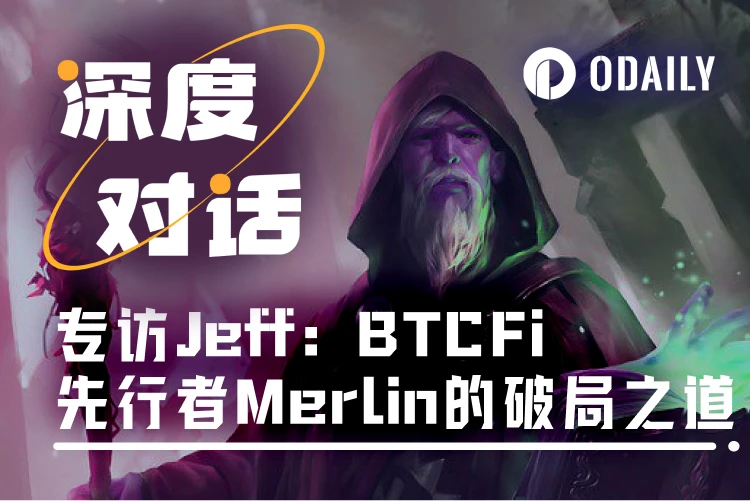Odaily interviews Merlin founder Jeff: I want to give up every day, but I still look forward to going through the cycle
Asli | Odaily Planet Daily ( @OdailyChina )
Penulis: Golem ( @web3_golem )

In the past few days, Bitcoin has broken through $120,000 to set a new high, but the higher the price of Bitcoin rises, the quieter the Bitcoin ecosystem curled up in the corner seems. Either explode in silence or perish in silence, although the Bitcoin ecosystem has gradually disappeared from the publics sight, there are still people who stick to it, and BTCFi pioneer Merlin is one of them.
As Bitcoin continues to hit new highs and the altcoin market picks up, Odaily Planet Daily had the honor of having a conversation with Merlin founder Jeff. In the conversation, Jeff elaborated on the details of Merlins BTCFi and AI Agent products and disclosed follow-up plans, and announced that the RWA project will be launched in the Bitcoin ecosystem in early August.
In addition, Jeff also shared for the first time his inner thoughts and feelings from the founding of Merlin to the present, from under the spotlight to in the corner of the stage. For the sake of clarity, Odaily Planet Daily will briefly summarize the interview and QA as follows, enjoy~
How Merlin “Reshapes BTC”
Odaily: Merlin was one of the first Bitcoin L2s to explore BTCFi, but in early 2024, BTCFi was immature in terms of technology, ecology, and community awareness, so Merlin was also controversial at the time, such as questioning Merlins TVL data disk, problems with security custody technology, and imitation of Ethereum L2. But now it seems that these have also provided valuable experience for the subsequent BTCFi protocol. So why was Merlin willing to explore BTCFi ahead of the market at the time? Please share your thoughts when making this decision.
Jef: I think it was mainly market opportunities. When we were working on Merlin, inscriptions and runes were the hottest, and the market demand was strong. On the one hand, the market was keen to issue assets on the Bitcoin mainnet; on the other hand, investors at the time not only wanted to hold Bitcoin, but also hoped that it would have interest-bearing properties.
So we started exploring BTCFi based on this market demand. However, Merlin had a relatively large overall voice and potential at the time, so there was definitely more attention and controversy.
But today, looking back, whether it is Babylon or Solv, or various BTCFi products, the product design ideas are the same as Merlins at that time. For example, from a technical point of view, everyone had always hoped to achieve property rights confirmation through BitVM or op-cat on the Bitcoin mainnet , but in fact, its technical progress was not as fast as we imagined. So whether it is Babylon or Solv, they are still using the same technical solution we used back then, and this set of technical solutions has been verified in practice to be very pragmatic and safe.
Odaily: BTCFi has gone through more than a year of development. What do you think of the current market landscape?
Jef: I think BTCFi is now relatively stable in terms of product form and technology. Regardless of whether it is a new or old project, the solutions used by each company are actually similar. But I think the biggest bottleneck BTCFi is facing now is the rate of return, including whether the rate of return can be higher and whether the overall BTC capacity can be larger.
For holders who hold 100 or even 1,000 BTC, such a large capacity cannot generate a long-term effective source of income, judging from the current on-chain activity. The current yield of BTCFi products is much lower than a year ago. Therefore, people are now exploring more about the source of BTCFis interest and expanding its capacity.
Odaily: In the early days of BTCFi’s development, most projects attracted users through airdrops, but now most projects have already done TGE. So after there are no airdrop incentives, do you think increasing the staking yield is the best way to retain users?
Jef: tetesan udaras can only be a catalyst, it is not a healthy, long-term model , after all, no project can always stimulate users to stake by issuing coins. So after the airdrop, it is normal for users to churn out, but I don’t think it is a bad thing, because for a long-term BTC user, the need for staking to earn interest is definitely long-term, and we serve them more.
As long as these users are provided with a long-term and stable source of income, and the technical solutions used can reassure them, they will be willing to stay and continue to keep their BTC here for financial management.
Odaily: The native Bitcoin staking product launched by Merlin on June 24 was very popular in the market, and the first 50 BTC share was fully subscribed within 27 minutes. So, what are the main sources of Merlins Bitcoin staking income?
Jeff: The first source is multi-chain liquidity provision. For example, in the recent cooperation between Merlin and Sui, Merlin, as a liquidity provider, obtains income by forming LPs in the liquidity pool on Sui, including official subsidy income and handling fee income generated by on-chain activities.
The second source is similar to trading arbitrage. It mainly uses BTC as collateral to obtain different tokens, and there will be certain arbitrage opportunities between different tokens.
The third source is to provide AVS services for some new projects. Some new projects need BTC assets to provide verification services for them, and in return they will allocate some airdrops to us.
In addition, as a user, if you hold MBTC, you can choose to earn income in different chains and DeFi protocols. However, the Bitcoin staking we launched is equivalent to opening a vault to help investors do some more stable and safe financial management. Although the yield may not be as high as the users own arbitrage, the advantage is peace of mind and safety.
Odaily: There are many listed companies in the market that are building up Bitcoin reserves. Do you think they are likely to participate in BTCFi in the future?
Jef: I personally think that these companies that use Bitcoin as reserves will definitely participate in BTCFi in the future, because when their BTC reserves reach a certain level, they must consider how to generate interest. However, the way they participate in BTCFi will definitely not be to directly put it on the chain for financial management, but to participate in BTCFi in their own way, such as introducing more custodians to participate, and then minting a packaged version of BTC to circulate in the market to obtain a long-term and stable income.
But Merlin is more concerned about how retail investors can participate in BTCFi, which mainly includes three aspects: hold, earn and invest. Hold and earn are easy to understand, and invest means that Merlin uses chain abstraction technology and AI to help users use Bitcoin for investment.
We launched this product in January this year. For example, when TRUMP was issued, many investors actually used BTC on the Merlin chain to buy TRUMP, and this was when the market value of TRUMP was only a few hundred million US dollars. This was mainly due to the abstract technology of the Merlin chain, which enabled the entire transaction to be completed in less than 1 second. After TRUMP rose, they sold it back for BTC, which was equivalent to a round of investors having more Bitcoins.
So what we are considering is to provide more such opportunities for retail investors. In order to seize various opportunities on the chain, retail investors may hold various altcoins in many wallets, such as SOL, ETH and BNB. But this also creates two problems. First, these assets cannot outperform BTC in many cases, and retail investors principal cannot outperform the market in the first place; second, the risk opportunities of each chain occur randomly or intermittently, which is very troublesome for retail investors, both in terms of security and operation.
Then, Merlin’s solution for users is that as long as they have BTC in their wallets, they can participate in these speculative opportunities on various chains. For example, they can directly use BTC to buy Meme on Sui or BSC, and after selling these assets, they can return to the user’s wallet in the form of BTC. In this way, retail investors do not need to hold more other tokens, and they can still earn BTC in the end.
Odaily: Merlin has previously announced a strategic partnership with wBTC DAO, but Merlin also has its own packaged version of BTC. In what aspects are the complementarities between MBTC and wBTC reflected? Will there be a specific liquidity sharing plan?
Jef: wBTC is one of the earliest packaged versions of BTC in the market with the strongest consensus, with tens of billions of dollars of liquidity distributed on various chains. As an early asset that has just been born for a year, we also hope that MBTC can expand to more chains and protocols.
Merlin is now one of the nine members of wBTC DAO. On the one hand, we can learn from them about their experience in regulation and security. On the other hand, MBTC and wBTC will exist on more chains at the same time in the future, and the two tokens will be interchangeable at a nearly 1:1 ratio, providing users with lower wear and tear while opening up different DeFi application scenarios, allowing users to better trade, arbitrage, and earn interest in both DeFi scenarios where MBTC is active and scenarios where wBTC is active.
Bitcoin Holder’s Crypto Trading Portal: Merlin Wizard
Odaily: In addition to Bitcoin staking, another important product of Merlin is the AI assistant Merlin Wizard, and version 0.3 was recently released. What are its core functions and the pain points it solves?
Jef: Wizard currently has two main functions. The first is to assist in trading decisions. We currently have all the on-chain data of the four mainstream chains (Ethereum, Solana, Base, and BSC), as well as the off-chain data of the top hundreds of market value projects on CMC. With this data, AI can help users answer some questions or make some trading decisions.
The second function is transaction execution . Because for new users nowadays, learning how to use wallets of four or five different chains and DeFi protocols on each chain has a high learning threshold and cost. Wizard can help users directly complete some transactions, such as buying TRUMP at a certain price, and then selling it at a certain price, or specifying how much money to spend to directly participate in new issuance and IDO on BSC, etc.
All these operations can be completed by an AI, but the prerequisite is to obtain user authorization . Therefore, the final control of the signature is still in the hands of the user, but all the processes in the middle are solved by AI to help people, and users do not need to do some complicated learning or watch some step-by-step tutorials.
At the same time, around the beginning of August, we will directly launch the Wizard 1.0 version . Users will then be able to communicate directly with this AI Agent and use BTC to complete various transactions, which will provide a better experience than the current version.
Odaily: So what kind of big model is behind Merlin Wizard? How high is the maintenance cost?
Jef: In fact, most Agents now use hybrid large models. For example, we use Claude for language-oriented ones, and ChatGPT for data-oriented ones. The maintenance cost is not bad, because Cyrpto itself does not have many users. If the daily active users are maintained at a few thousand, the monthly cost is about a few hundred to a few thousand US dollars. These costs can be covered by the income of Merlin chain itself.
Odaily: The AI Agent craze in the kriptocurrency world has somewhat subsided. Why, as a BTC ecosystem project, does Merlin continue to choose to focus on this sector?
Jef: Actually, a relatively near future that everyone can see is that AI helps users complete various complex operations. Because the crypto industry has developed to the present, there are so many chains, protocols, wallets, and assets that users are often overloaded with information. Therefore, for some new people born after 2005 or even 2010, it is too complicated to understand this history. Many new people dont even know and use Metamask.
So I think if this trend continues, the future entry point for crypto trading will definitely evolve into an AI agent. For example, when you open a browser or mobile phone, you no longer need to open Metamask or OKX wallet, but an AI Agent will help users complete various transactions as a full-time assistant.
No matter who finally achieves this goal, I think this industry will welcome more new users as a result.
Odaily: Does Merlin have more product plans for individual investors with better applicability in the future?
Jeff: We expect to launch a new project in early August to introduce RWA into the BTC ecosystem. Specifically, some real-life assets, such as collectibles, animation, and IP, will be tokenized, and then on-chain transfers, transactions, lotteries, etc. will be realized.
This plan is consistent with Merlin’s core goal, which is to make BTC more useful. At the same time, it can also meet the needs of investors who want to hold BTC to outperform the market, but also want to participate in speculation to pursue high risk and high returns. Providing investors with these speculative channels is also the direction of our long-term efforts.
Merlin is pushed forward by the ecological community
Odaily: Then let’s talk about Merlin itself. As the overall Bitcoin ecosystem is declining, Merlin’s popularity and attention have greatly decreased compared to last year. Do you and your team feel a sense of disappointment?
Jef: Objectively speaking, there is definitely a sense of gap, but from a cyclical perspective, this is unavoidable. Last year, there were probably more than 100 Bitcoin ecosystem projects in the same period as us, but now 80% of them are gone. So I think how to cross the cycle is a very important proposition in the Crypto industry.
A typical example is Solana. After the FTX incident, it also faced a situation of everyone pushing down the wall when it falls, but in the end Solana became popular again relying on its own performance and ecological construction.
So for a project, the spotlight being removed is not the biggest problem. The most difficult thing is to persist in finding the right direction when the market heat is not on your side.
Odaily: What difficult times did the team go through? What are the differences in team atmosphere and work style in the two completely different periods?
Jef: First of all, our revenue has definitely decreased a lot, but the team is still relatively stable . We have more than 30 people in the team, and basically no one has left.
Besides, our team actually has more Web2 genes, so everyone is quite used to this kind of lonely time. On the contrary, when the market is hot, everyone will be a little overloaded.
Odaily: Was there any tribute when Merlins token MERL was launched on Binance Alpha? Because listing airdrops will bring selling pressure, what was the reason for choosing to launch on Alpha at that time?
Jeff: If “tribute” means airdropping to Binance platform users, then it definitely happened, but if it means to Binance, then it definitely didn’t happen. The airdrop did generate about $3-4 million in token selling pressure, but we digested it relatively well. After Binance Alpha was launched, MERL’s decline was very small.
The reason for listing on Binance Alpha is that we hope to enter more trading markets, bring the Bitcoin ecosystem to a larger circle, and be seen and discussed by more people. This is also the purpose of MERL’s launch on Kraken, one of the two major compliant exchanges in the United States, in early July.
In order to be listed on Kraken, our team spent more than six months preparing relevant compliance materials. There was no such thing as tribute, and at most we conducted some trading activities. In fact, not many project parties are willing to spend this time, but we think it is necessary, and these experiences also provide some help for the future listing on Coinbase.
Odaily: But whether it is Binance Alpha or AI Agent, these are hot spots in the cryptocurrency circle at a certain time. When Meme was popular at the end of 2024, Merlin also tried to build the Meme ecosystem with BTC.Fun. It can be seen that Merlin has a strong ability to respond to market hot spots, but is this Merlins behavior of blindly chasing hot spots for market heat, and can this really help the BTC ecosystem achieve large-scale adoption?
Jef: I think it’s hard for anyone to catch the hot spots right away, because products have development cycles. For example, the domain name of BTC.Fun was actually registered very early, probably in February or March 2024, but the product itself took a long time to develop, so when it came out, it just happened to be when all chains were working on pumps.
Selain itu, Merlin is not simply an application for a certain track, but a public chain. So, as a public chain, we must seize the market hot spots. When Pump.fun was popular, everyone was working on Pump, whether it was Ethereum, BSC, Base or Tron.
As a public chain, Merlins main task is to support developers. When a concept or product becomes popular, there will naturally be developers willing to do similar things, but we cannot stop developers just because it does not conform to our ideas. Therefore, I think that building an ecosystem is different from building an application. Public chains are often pushed forward by the community users of the entire ecosystem.
But I still think that no one can succeed by just catching hot spots, never. For example, when Inscription was popular, the teams that finally succeeded were the projects that persisted for a long time when the Inscription ecosystem was at its bleakest. From the end of last year to now, AI has been sneered at by most Web3 users, who think that this track has been popular, but Merlin is still persisting.
So it doesn’t matter what you grab, the key is whether you can stick to it and deliver what users really care about. The concept of BTCFi was also first proposed by Merlin, but the market finally became popular about a year after we proposed it.
There are moments every day when you want to give up
Odaily: Bitcoin has recently broken through the $120,000 mark to set a new high. How do you view the trend of Bitcoin in this cycle? Will the bull market continue? Will it bring more attention to the Bitcoin ecosystem?
Jef: I am still optimistic about the market trend, because we are in an institutional bull market. For the Bitcoin ecosystem, everyone has an optimistic expectation that after Bitcoin rises, the rotation of sectors will make the Bitcoin ecosystem gain more attention. I think this logic is reasonable. But what the market will choose in the end, BTCFi, Inscription Rune, or RWA, I think this is difficult to predict.
Odaily: Since you founded Merlin, which period was the most stressful? What supported Merlin to persevere?
Jef: I think the pressure has always been average, but the time when Merlin was listed was definitely the most stressful. After all, we gave users a 20% airdrop at that time, so facing the airdrop selling pressure and the markets expectations for prices, etc., the pressure was quite high at that time.
The reason why we have persisted until now is first of all our belief in the Bitcoin ecosystem, and we believe that this is a long-term track. In addition, we have not built the Bitcoin ecosystem overnight. In fact, you will find that there are no new Bitcoin ecosystem projects that can be done now, and the difficulty of building from 0 to 1 has increased. So we believe that since Merlin has established certain thresholds and barriers, and we firmly believe that this track has long-term value, we have persisted.
But to be honest, there are moments every day when I think “I might as well give up”. However, when I see the entire industry recovering and think about the project coming back into everyone’s attention and being able to do better again, we choose to move on, just like all the staunch builders of the Bitcoin ecosystem.
Odaily: In any case, Merlin is a BTC Layer 2 project that goes through cycles. During the entire construction cycle, what insights do you most want to share?
Jeff: My biggest personal experience is that doing projects in this cycle is extremely difficult. All the challenges faced in this cycle are actually far greater than those in the previous cycles.
Perhaps most developers are now more willing to do some short-term investment and speculative projects. Although Bitcoin does not care about these, this is not a good thing for the entire Web3 ecosystem.
I still hope that more builders and users can join in to build Web3.
This article is sourced from the internet: Odaily interviews Merlin founder Jeff: I want to give up every day, but I still look forward to going through the cycle
Related: One week of token unlocking: 5 projects unlocked tokens worth about $19 million
There are only 5 unlocked projects this week, among which VENOM has a relatively high unlocking ratio, which is 2.8% of the circulation. Venom Project Twitter: https://twitter.com/VenomFoundation Project website: https://venom.network/ Number of unlocked tokens this time: 59.31 million Amount unlocked this time: Approximately 9.49 million US dollars Venom is a Turing-complete proof-of-stake blockchain that uses a Byzantine Fault Tolerant consensus algorithm for block validation and creation as well as network security, using dynamic sharding to increase its transaction throughput and network capacity. The specific release curve is as follows: Mocaverse Project Twitter: https://x.com/Moca_Network Project website: https://www.mocaverse.xyz/ Number of unlocked tokens this time: 44.08 million Amount unlocked this time: Approximately 3.13 million US dollars Mocaverse is a metaverse product under Animoca Brands that is building Web3 native tools to empower products…







